六年级英语语法 如何改写句子
- 格式:doc
- 大小:40.00 KB
- 文档页数:3
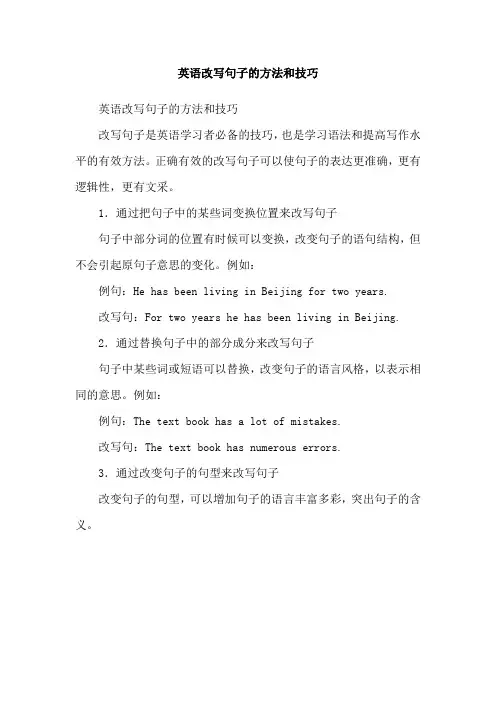
英语改写句子的方法和技巧
英语改写句子的方法和技巧
改写句子是英语学习者必备的技巧,也是学习语法和提高写作水平的有效方法。
正确有效的改写句子可以使句子的表达更准确,更有逻辑性,更有文采。
1.通过把句子中的某些词变换位置来改写句子
句子中部分词的位置有时候可以变换,改变句子的语句结构,但不会引起原句子意思的变化。
例如:
例句:He has been living in Beijing for two years.
改写句:For two years he has been living in Beijing.
2.通过替换句子中的部分成分来改写句子
句子中某些词或短语可以替换,改变句子的语言风格,以表示相同的意思。
例如:
例句:The text book has a lot of mistakes.
改写句:The text book has numerous errors.
3.通过改变句子的句型来改写句子
改变句子的句型,可以增加句子的语言丰富多彩,突出句子的含义。
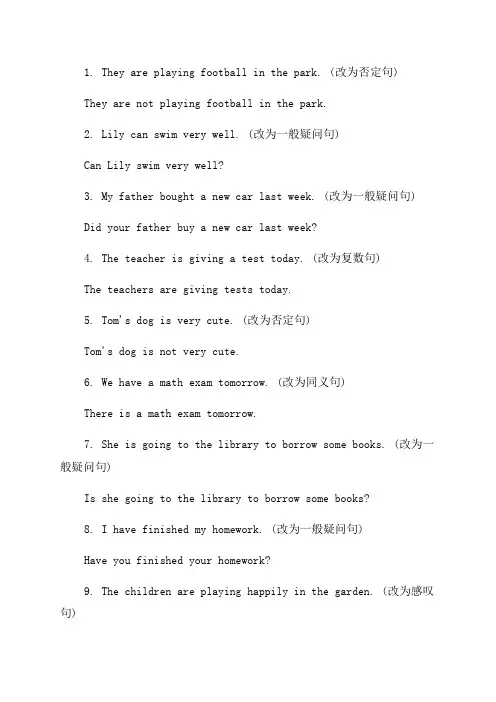
1. They are playing football in the park. (改为否定句)They are not playing football in the park.2. Lily can swim very well. (改为一般疑问句)Can Lily swim very well?3. My father bought a new car last week. (改为一般疑问句)Did your father buy a new car last week?4. The teacher is giving a test today. (改为复数句)The teachers are giving tests today.5. Tom's dog is very cute. (改为否定句)Tom's dog is not very cute.6. We have a math exam tomorrow. (改为同义句)There is a math exam tomorrow.7. She is going to the library to borrow some books. (改为一般疑问句)Is she going to the library to borrow some books?8. I have finished my homework. (改为一般疑问句)Have you finished your homework?9. The children are playing happily in the garden. (改为感叹句)How happily the children are playing in the garden!10. He doesn't like playing basketball. (改为肯定句) He likes playing basketball.。
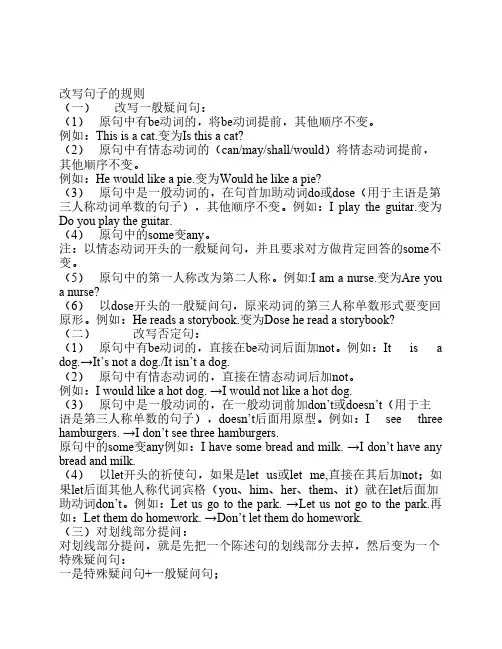
改写句子的规则(一)改写一般疑问句:(1)原句中有be动词的,将be动词提前,其他顺序不变。
例如:This is a cat.变为Is this a cat?(2)原句中有情态动词的(can/may/shall/would)将情态动词提前,其他顺序不变。
例如:He would like a pie.变为Would he like a pie?(3)原句中是一般动词的,在句首加助动词do或dose(用于主语是第三人称动词单数的句子),其他顺序不变。
例如:I play the guitar.变为Do you play the guitar.(4)原句中的some变any。
注:以情态动词开头的一般疑问句,并且要求对方做肯定回答的some不变。
(5)原句中的第一人称改为第二人称。
例如:I am a nurse.变为Are you a nurse?(6)以dose开头的一般疑问句,原来动词的第三人称单数形式要变回原形。
例如:He reads a storybook.变为Dose he read a storybook?(二)改写否定句:(1)原句中有be动词的,直接在be动词后面加not。
例如:It is a dog.→It’s not a dog./It isn’t a dog.(2)原句中有情态动词的,直接在情态动词后加not。
例如:I would like a hot dog. →I would not like a hot dog.(3)原句中是一般动词的,在一般动词前加don’t或doesn’t(用于主语是第三人称单数的句子),doesn’t后面用原型。
例如:I see three hamburgers. →I don’t see three hamburgers.原句中的some变any例如:I have some bread and milk. →I don’t have any bread and milk.(4)以let开头的祈使句,如果是let us或let me,直接在其后加not;如果let后面其他人称代词宾格(you、him、her、them、it)就在let后面加助动词don’t。
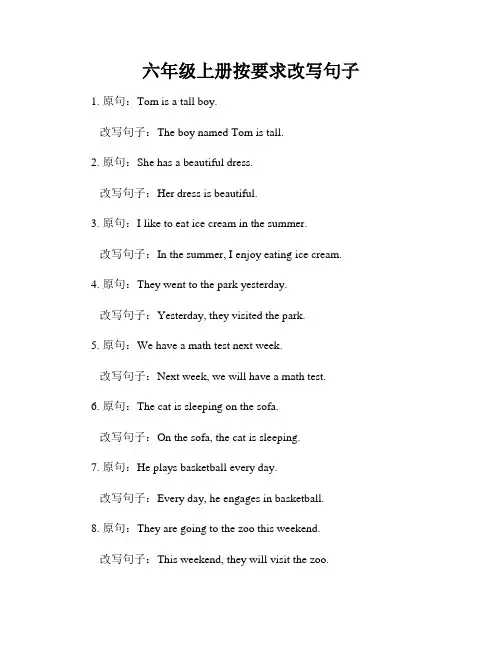
六年级上册按要求改写句子1. 原句:Tom is a tall boy.改写句子:The boy named Tom is tall.2. 原句:She has a beautiful dress.改写句子:Her dress is beautiful.3. 原句:I like to eat ice cream in the summer.改写句子:In the summer, I enjoy eating ice cream. 4. 原句:They went to the park yesterday.改写句子:Yesterday, they visited the park.5. 原句:We have a math test next week.改写句子:Next week, we will have a math test.6. 原句:The cat is sleeping on the sofa.改写句子:On the sofa, the cat is sleeping.7. 原句:He plays basketball every day.改写句子:Every day, he engages in basketball.8. 原句:They are going to the zoo this weekend.改写句子:This weekend, they will visit the zoo.9. 原句:She has long, curly hair.改写句子:Her hair is long and curly.10. 原句:I am going to the library to borrow a book.改写句子:To borrow a book, I am going to the library.通过对六年级上册句子进行改写,我们可以通过改变句子的词语顺序、增加或删除一些词汇来达到题目的要求。
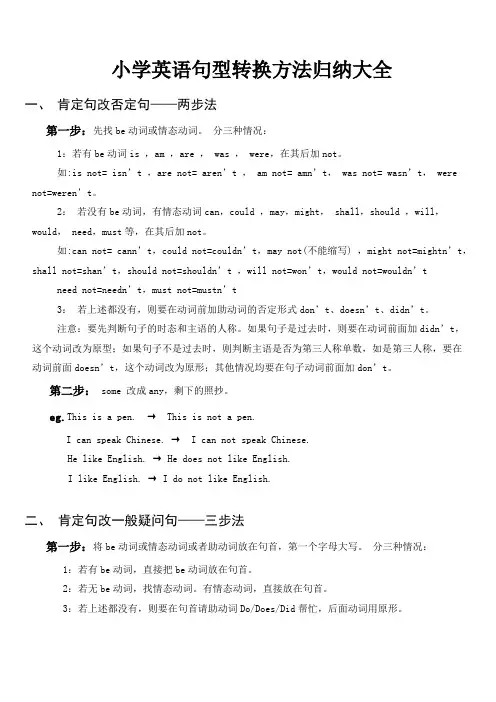
小学英语句型转换方法归纳大全一、肯定句改否定句——两步法第一步:先找be动词或情态动词。
分三种情况:1:若有be动词is ,am ,are , was , were,在其后加not。
如:is not= isn’t,are not= aren’t, am not= amn’t, was not= wasn’t, were not=weren’t。
2:若没有be动词,有情态动词can,could ,may,might, shall,should ,will,would, need,must等,在其后加not。
如:can not= cann’t,could not=couldn’t,may not(不能缩写) ,might not=mightn’t,shall not=shan’t,should not=shouldn’t ,will not=won’t,would not=wouldn’t need not=needn’t,must not=mustn’t3:若上述都没有,则要在动词前加助动词的否定形式don’t、doesn’t、didn’t。
注意:要先判断句子的时态和主语的人称。
如果句子是过去时,则要在动词前面加didn’t,这个动词改为原型;如果句子不是过去时,则判断主语是否为第三人称单数,如是第三人称,要在动词前面doesn’t,这个动词改为原形;其他情况均要在句子动词前面加don’t。
第二步: some 改成any,剩下的照抄。
eg.This is a pen. →This is not a pen.I can speak Chinese.→I can not speak Chinese.He like English. →He does not like English.I like English.→I do not like English.二、肯定句改一般疑问句——三步法第一步:将be动词或情态动词或者助动词放在句首,第一个字母大写。

小学六年级英语句型转换方法归纳大全如:Do you like English?Does he speak Chinese?Did they finish their homework?第二步:将句子中的主语放在be动词或情态动词或助动词后面,动词用原形。
如:Do you like English?Does he speak Chinese?Did they finish their homework?第三步:在句子末尾加问号。
如:Do you like English?Does he speak Chinese?Did they finish their homework?三、肯定句改祈使句——两步法第一步:将句子中的主语you省略。
如:Study hard.→Hard.XXX.→Quiet.第二步:在句子末尾加上句号或感叹号。
如:Study hard.Be quiet!Original article:XXX and I went to the park yesterday。
We played catch and had a ic。
The weather was nice and sunny。
We saw some kids XXX。
We had a great time.Corrected and rewritten:XXX。
my friend and I went to the park。
We played catch and had a ic on the grass。
The weather was beautiful and sunny。
While we were there。
we saw some children flying kites and some people walking their dogs。
It was a wonderful day and we had a lot of fun.When forming a n in English。
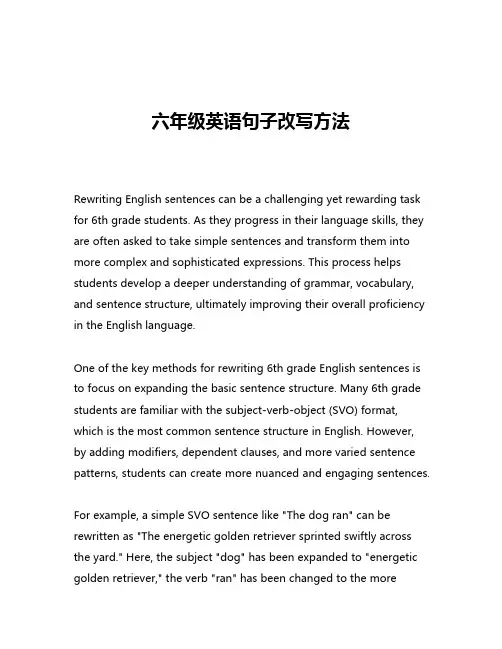
六年级英语句子改写方法Rewriting English sentences can be a challenging yet rewarding task for 6th grade students. As they progress in their language skills, they are often asked to take simple sentences and transform them into more complex and sophisticated expressions. This process helps students develop a deeper understanding of grammar, vocabulary, and sentence structure, ultimately improving their overall proficiency in the English language.One of the key methods for rewriting 6th grade English sentences is to focus on expanding the basic sentence structure. Many 6th grade students are familiar with the subject-verb-object (SVO) format, which is the most common sentence structure in English. However, by adding modifiers, dependent clauses, and more varied sentence patterns, students can create more nuanced and engaging sentences.For example, a simple SVO sentence like "The dog ran" can be rewritten as "The energetic golden retriever sprinted swiftly across the yard." Here, the subject "dog" has been expanded to "energetic golden retriever," the verb "ran" has been changed to the moredescriptive "sprinted swiftly," and a prepositional phrase "across the yard" has been added to provide more context.Another effective technique for rewriting 6th grade English sentences is to incorporate more complex grammatical structures, such as compound and complex sentences. Compound sentences, which combine two independent clauses with a coordinating conjunction (e.g., "and," "but," "or"), allow students to express more sophisticated ideas and relationships between concepts. Complex sentences, which include an independent clause and one or more dependent clauses, enable students to convey nuanced thoughts and provide additional context or explanation.For instance, a simple sentence like "The girl played soccer" could be rewritten as a compound sentence: "The girl played soccer, and she scored two goals." Alternatively, it could be transformed into a complex sentence: "Although the weather was rainy, the girl played soccer and scored two goals." These rewritten versions demonstrate a deeper understanding of sentence structure and the ability to express more complex ideas.In addition to expanding sentence structure, 6th grade students can also improve their sentence rewriting skills by focusing on word choice and vocabulary. By replacing basic verbs, nouns, and adjectives with more precise, vivid, and descriptive language,students can create sentences that are more engaging and impactful. This might involve substituting a generic verb like "said" with a more specific and evocative one, such as "whispered," "exclaimed," or "muttered." Similarly, a simple adjective like "good" could be replaced with a more nuanced descriptor, such as "exceptional," "remarkable," or "extraordinary."Consider the sentence "The book was good." This could be rewritten as "The captivating novel enthralled the reader with its exceptional storytelling." Here, the generic noun "book" has been replaced with the more specific "captivating novel," the bland verb "was" has been changed to the more dynamic "enthralled," and the adjective "good" has been transformed into the more descriptive "exceptional."Furthermore, 6th grade students can practice rewriting sentences by incorporating more varied sentence structures and patterns. This might involve inverting the typical subject-verb order, using passive voice, or experimenting with different placement of modifiers and dependent clauses. By exploring these alternative sentence structures, students can add greater complexity and nuance to their writing, ultimately enhancing their overall command of the English language.For instance, the sentence "The student completed the assignment" could be rewritten in passive voice as "The assignment wascompleted by the student." Alternatively, it could be transformed into a more complex structure: "After carefully reviewing the instructions, the diligent student completed the assignment on time."Throughout the process of rewriting 6th grade English sentences, it is important for students to maintain a focus on clear, coherent, and grammatically correct expression. While experimenting with more sophisticated language and sentence structures, students must ensure that their rewritten sentences still convey the intended meaning effectively and adhere to the rules of English grammar.To achieve this balance, 6th grade students can engage in various exercises and activities that encourage them to practice and refine their sentence rewriting skills. This might include peer editing, where students exchange their rewritten sentences and provide constructive feedback to one another. Teachers can also incorporate sentence-level exercises into their lesson plans, such as having students identify opportunities for rewriting in sample passages or providing them with simple sentences to transform into more complex expressions.By consistently practicing and refining their sentence rewriting abilities, 6th grade students can develop a stronger command of the English language, enhance their writing skills, and preparethemselves for the more advanced linguistic challenges they will encounter in the years to come. Through this process, they not only improve their technical proficiency but also cultivate the critical thinking and creative problem-solving skills that are essential for success in academic and professional settings.。
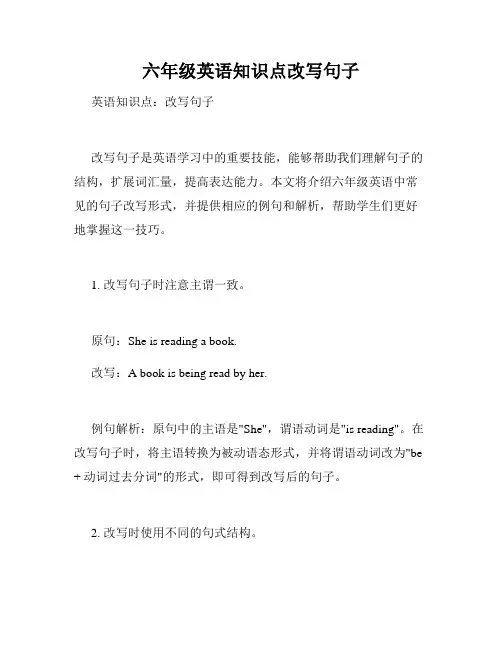
六年级英语知识点改写句子英语知识点:改写句子改写句子是英语学习中的重要技能,能够帮助我们理解句子的结构,扩展词汇量,提高表达能力。
本文将介绍六年级英语中常见的句子改写形式,并提供相应的例句和解析,帮助学生们更好地掌握这一技巧。
1. 改写句子时注意主谓一致。
原句:She is reading a book.改写:A book is being read by her.例句解析:原句中的主语是"She",谓语动词是"is reading"。
在改写句子时,将主语转换为被动语态形式,并将谓语动词改为"be + 动词过去分词"的形式,即可得到改写后的句子。
2. 改写时使用不同的句式结构。
原句:I have a red pen.改写:There is a red pen in my possession.例句解析:原句为正常的陈述句形式。
在改写时,可以使用"There is/are"的句式来引出主语,增加句子的表达形式。
3. 改写句子时注意动词时态的调整。
原句:Lucy went to the park yesterday.改写:The park was visited by Lucy yesterday.例句解析:原句中的动词时态为一般过去时。
在改写句子时,将主语改为被动语态形式,并将动词的时态调整为相应的过去时。
4. 改写句子时注意改变句子的语气。
原句:Don't touch the painting!改写:Let the painting be untouched!例句解析:原句为祈使句,表示命令或建议。
在改写时,将句子转换为被动语态形式,使其成为一种更委婉的陈述。
5. 改写句子时注意改变句子的结构。
原句:He is tall and thin.改写:He has a tall and thin figure.例句解析:原句为简单的主系表结构。
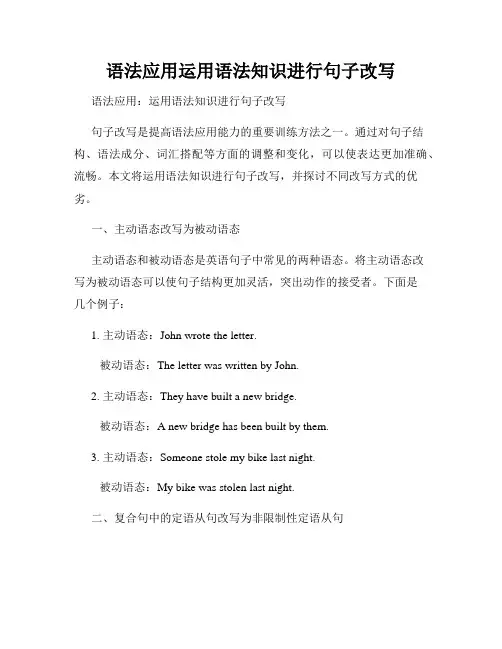
语法应用运用语法知识进行句子改写语法应用:运用语法知识进行句子改写句子改写是提高语法应用能力的重要训练方法之一。
通过对句子结构、语法成分、词汇搭配等方面的调整和变化,可以使表达更加准确、流畅。
本文将运用语法知识进行句子改写,并探讨不同改写方式的优劣。
一、主动语态改写为被动语态主动语态和被动语态是英语句子中常见的两种语态。
将主动语态改写为被动语态可以使句子结构更加灵活,突出动作的接受者。
下面是几个例子:1. 主动语态:John wrote the letter.被动语态:The letter was written by John.2. 主动语态:They have built a new bridge.被动语态:A new bridge has been built by them.3. 主动语态:Someone stole my bike last night.被动语态:My bike was stolen last night.二、复合句中的定语从句改写为非限制性定语从句定语从句在复合句中起到修饰名词或代词的作用,增加了句子的信息量。
将定语从句改写为非限制性定语从句,可以使句子结构更加简练,同时保留所需的附加信息。
举例如下:1. 定语从句:The book that I borrowed from the library is very interesting.非限制性定语从句:The book, which I borrowed from the library, is very interesting.2. 定语从句:The girl who is wearing a red dress is my sister.非限制性定语从句:The girl, who is wearing a red dress, is my sister.3. 定语从句:The student who won the competition received a scholarship.非限制性定语从句:The student, who won the competition, receiveda scholarship.三、条件状语从句改写为倒装句条件状语从句在句子中起到表示条件的作用,常以if或unless引导。

六年级英语句型转换及答案在六年级的英语学习中,学生们需要掌握并运用多种英语句型进行表达。
句型转换是提高语言运用能力的重要一环,通过对原句进行改写,学生们可以更加灵活地运用所学的语法知识来表达自己的意思。
下面将详细介绍一些常见的六年级英语句型转换,并给出相应的答案。
1. 肯定句转否定句:将肯定句改为否定句时,通常需要在动词前加上否定词not。
例如:She is my friend. → She is not my friend.2. 否定句转肯定句:将否定句改为肯定句时,通常需要去掉否定词not。
例如:He doesn't like soccer. → He likes soccer.3. 一般疑问句转陈述句:将一般疑问句改为陈述句时,通常需要用肯定或否定回答中的一个来作为答句。
例如:Do you like ice cream? → Yes, I do. / No, I don't.4. 陈述句转特殊疑问句:将陈述句改为特殊疑问句时,通常需要将疑问词放在句首。
例如:You are from China. → Where are you from?5. 一般现在时转一般过去时:将一般现在时改为一般过去时时,通常需要将动词的过去式形式。
例如:She sings well. → She sang well.6. 一般过去时转一般将来时:将一般过去时改为一般将来时时,通常需要在动词前加助动词will。
例如:They visited the museum last week. → They will visit the museum next week.7. 现在进行时转一般现在时:将现在进行时改为一般现在时时,通常需要去掉be动词,并根据主语的单复数形式来决定动词的形式。
例如:I am reading a book. → I read a book.8. 一般现在时转现在进行时:将一般现在时改为现在进行时时,通常需要在动词前加上be动词,并将动词的原形变为-ing形式。
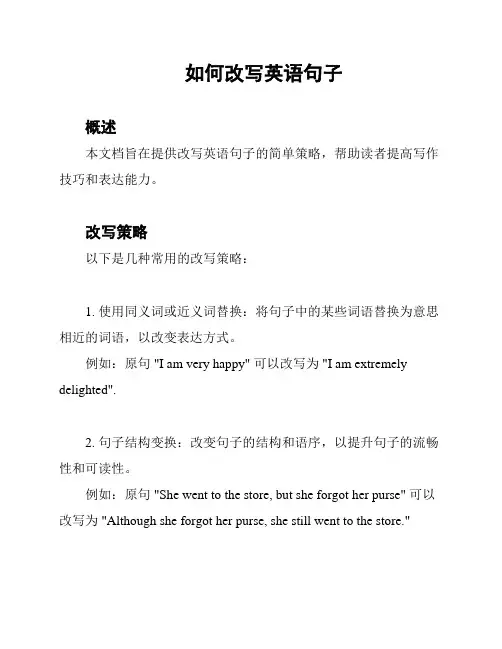
如何改写英语句子概述本文档旨在提供改写英语句子的简单策略,帮助读者提高写作技巧和表达能力。
改写策略以下是几种常用的改写策略:1. 使用同义词或近义词替换:将句子中的某些词语替换为意思相近的词语,以改变表达方式。
例如:原句 "I am very happy" 可以改写为 "I am extremely delighted".2. 句子结构变换:改变句子的结构和语序,以提升句子的流畅性和可读性。
例如:原句 "She went to the store, but she forgot her purse" 可以改写为 "Although she forgot her purse, she still went to the store."3. 使用不同的语态:将句子的语态从主动变为被动,或从被动变为主动,以改变句子的强调和焦点。
例如:原句 "The book was written by Jane" 可以改写为 "Jane wrote the book."4. 分解长句:将过长或复杂的句子分解为几个简单的句子,以增加句子的清晰度和易读性。
例如:原句 "By studying hard, practicing regularly, and seeking feedback, students can improve their English skills" 可以改写为"Studying hard, practicing regularly, and seeking feedback are ways for students to improve their English skills."5. 使用否定表达:将肯定表达转换为否定表达,使句子具有戏剧性或强烈的表达效果。
【导语】英语学习是为了⾯对将来的全球化世界所必须要坚持的学习。
尤其随着中国的进⼀步发展,世界各地的⼈都会来中国从事,掌握英语可以让你在将来的交流中先于⼀步。
以下是整理的《⼩学六年级英语句⼦改写》,希望帮助到您。
【篇⼀】 1. Does he go to school on Monday? (改为肯定句) 2. Is Miss Fang reading a book in the office? (改为肯定句) 3. It’s a quarter past five. (换种意思表达) 4. Alice sits in front of Peter. (换种意思表达) 5. Don’t run in the classroom. (换种意思表达) 6. She has a new purse. (否定句,但句意不变) 7. Those are blunt pencils.(否定句,但句意不变) 8. Turn off the television. (否定句,但句意不变) 9. It’s a quarter to seven. (对划线部分提问) 10. Kitty is doing her homework in the bedroom. (对划线部分提问)【篇⼆】 1. I like watermelons and grapes. (改为否定句) 2. Please look and guess. (改为否定句) 3. These apples are crunchy. (改为否定句) 4. The lady walks on the road. (改为否定句) 5. The tree’s shadow is on the path. (改为⼀般疑问句) 6. The mouse can jump onto the door. (改为⼀般疑问句) 7. Danny plays football on Sundays. (改为⼀般疑问句) 8. I get up at half past six in the morning. (改为⼀般疑问句) 9. Do you have any cherries? (改为肯定句) 10. Is it twelve thirty in the afternoon? (改为肯定句)【篇三】 1. He always plays badminton with his friends on Thursday.(对划线部分提问) 2. They can have a holiday in Sanya. (对划线部分提问) 3. There are four seasons in a year. (对划线部分提问) 4. It is a quarter to two. (改为否定句) 5. Tom can make a model plane. (改为现在进⾏时态) 6. The shadow is long in the morning. (对划线部分提问) 7. I need a pair of swimming goggles for a swimming class.(对划线部分提问) 8. I am washing my face in the bathroom. (改为复数句) 9. We walk to school every day. (we改为he,其余做相应改变) 10. My mother wants dresses . My mother wants skirts. (改为选择疑问句)。
六年级英语改句子知识点英语是一门重要的学科,对于学生来说,掌握语法和句子结构非常关键。
在六年级阶段,学生们需要学习如何改写句子,以提高他们的语言表达能力。
下面是一些六年级英语改句子的知识点,帮助学生们更好地理解和运用。
一、改变句子的时态1. 一般现在时原句:I go to school every day.改句:I went to school yesterday.2. 一般过去时原句:She plays tennis every weekend.改句:She played tennis last weekend.3. 一般将来时原句:They will visit their grandparents next month.改句:They are going to visit their grandparents next month.二、改变句子的人称和数的形式1. 主动语态改为被动语态原句:The teacher gave us some homework.改句:We were given some homework by the teacher.2. 单数改为复数原句:This book belongs to my friend.改句:These books belong to my friends.3. 第三人称改为第一人称原句:He often goes swimming on weekends.改句:I often go swimming on weekends.三、改变句子的句型结构1. 否定句改为肯定句原句:We don't have any apples.改句:We have some apples.2. 肯定句改为否定句原句:She is eating an apple.改句:She is not eating an apple.3. 选择疑问句改为一般疑问句原句:Did you go to the park yesterday?改句:You went to the park yesterday, didn't you?四、改变句子的修饰方式1. 改变形容词的级别原句:This is a big house.改句:This is a huge house.2. 改变副词的级别原句:He runs very fast.改句:He runs extremely fast.3. 改变状语从句的结构原句:I will go to the party if I finish my homework.改句:If I finish my homework, I will go to the party.五、改变句子的语序和连词1. 前后倒装原句:He is running to catch the bus.改句:To catch the bus, he is running.2. 改变连词原句:I am tired because I stayed up late.改句:I am tired as I stayed up late.3. 改变并列连词原句:She is both smart and funny.改句:She is not only smart but also funny.六年级学生在学习改句子的过程中,需要注意以下几点:1. 理解句子的意思和结构是改写句子的关键,确保改写后的句子仍然表达相同的意思。
六年级英语改写句子知识点一、改写句子是英语语法中的一个重要部分,通过改写可以加深对句子结构、语法规则的理解,提高英语表达的准确性和流畅性。
下面是六年级英语改写句子的几个知识点。
1. 一般疑问句和肯定回答:原句:He is watching a movie.改写为一般疑问句:Is he watching a movie?肯定回答:Yes, he is.2. 否定回答:原句:She can swim.改写为否定句:She cannot swim.否定回答:No, she can't.3. 变一般疑问句为祈使句:原句:You can help me.改写为一般疑问句:Can you help me?变为祈使句:Help me, please.4. 变陈述句为感叹句:原句:It is a beautiful day.改写为感叹句:What a beautiful day it is!5. 变陈述句为选择疑问句:原句:She likes apples.改写为选择疑问句:Does she like apples or bananas?6. 变陈述句为强调句:原句:Tom likes soccer.改写为强调句:It is Tom who likes soccer.7. 用宾语从句改写句子:原句:I know the answer.改写为宾语从句:I know what the answer is.8. 变间接引语为直接引语:原句:She said that she was tired.改写为直接引语:She said, "I am tired."9. 变直接引语为间接引语:原句:She said, "I will come tomorrow."改写为间接引语:She said that she would come the next day.10. 变复合句的主从句顺序:原句:He will go to bed after he finishes his homework.改写为:After he finishes his homework, he will go to bed.以上是六年级英语改写句子的知识点总结,通过学习和掌握这些知识点,可以提高改写句子的能力,使英语表达更加准确和流畅。
六年级改写句子知识点句子改写是语法学习中重要的一部分,它旨在提高学生的句子运用能力和语言表达能力。
下面将介绍六年级改写句子的知识点,帮助学生更好地掌握相关技巧。
一、改变句子的时态1. 一般现在时变为一般过去时:原句:Tom plays football every day.改写:Tom played football every day.2. 一般过去时变为一般将来时:原句:They went to the park yesterday.改写:They will go to the park tomorrow.3. 一般现在时变为现在进行时:原句:She drinks milk every morning.改写:She is drinking milk now.4. 一般将来时变为一般现在时:原句:We will visit Beijing next week.改写:We visit Beijing every week.二、改变句子的人称和数1. 人称从第三人称变为第一人称:原句:He likes to eat apples.改写:I like to eat apples.2. 人称从第一人称变为第三人称:原句:I am reading a book.改写:She is reading a book.3. 数从单数变为复数:原句:The boy has a pet dog.改写:The boys have pet dogs.4. 数从复数变为单数:原句:They are playing games.改写:He is playing a game.三、改变句子的语序1. 疑问句变为陈述句:原句:Does she like swimming?改写:She likes swimming.2. 陈述句变为否定句:原句:He often goes to school by bus.改写:He doesn't often go to school by bus.3. 否定句变为疑问句:原句:She doesn't watch TV in the evening.改写:Does she watch TV in the evening?4. 变为间接引语:原句:She said, "I am hungry."改写:She said that she was hungry.四、改变句子的句型1. 肯定句变为感叹句:原句:The party is so much fun.改写:What a fun party it is!2. 简单句变为复合句:原句:He is reading a book.改写:While he is reading a book, I am doing my homework.3. 直陈句变为间接疑问句:原句:He asked, "Where is the library?"改写:He asked where the library was.4. 简单句变为并列句:原句:They like basketball. They like football.改写:They like basketball and they like football.通过学习以上改写句子的知识点,六年级的学生们可以更好地运用语法规则,合理改写句子,丰富语言表达能力。
六年级英语按要求改写句子当前,英语已经成为我国基础教育阶段必修课程之一。
下面是店铺带来的六年级英语按要求改写句子,欢迎阅读!六年级英语按要求改写句子精选It always rains in summer there. (改为一般疑问句,作肯定回答) It’s winter there. (对画线部分提问)I like autumn best. (改为否定句)Do you like spring? (加上winter 改为选择疑问句)Su Yang is (对画线部分提问)Please turn off the light. (改为否定句)I know his telephone number. (改为一般疑问句)It is a fine day today. (改为感叹句)The children have school today. (改为否定句)I’d like to join them.(改为一般疑问句)They are going to tomorrow.(对画线部分提问)I like collecting stamps and singing. (改为否定句)He often cleans his bedroom. (改为一般疑问句)My mother is in the garden. (对画线部分提问)David and Mike are going to this afternoon.(对画线部分提问) He did his homework in the classroom.(改为否定句)六年级英语按要求改写句子阅读Tom jumps as far as Mike. (改为否定句) I see a man behind me. (改为一般过去时)Helen is good at singing. (同义句)The boy can jump higher than the girl.(改为否定句)It is in summer in New York. (对画线部分提问)Liu Tao needs some pencils. (改为否定句)She is an English girl. (变为复数)They are our women doctors. (变为单数)Mary can fly. (变为一般疑问句,并作否定回答)I like playing volleyball. (改成第三人称单数he)She has a brother. (改为一般疑问句)Liu Tao drew some pictures yesterday. (改为否定句)Nancy usually reads magazines. (改为过去时)六年级英语按要求改写句子学习1. she does housework at the weekends. (改为否定句)2. mike runs as fast as ben. (改为一般疑问句)3. i get up at six thirty every day. (用yesterday afternoon替代every day) (对画线部分提问)5. mike runs fast. i run faster. (两句合并为一句)6. the policeman caught the thief. (改为一般疑问句,作否定回答) (对画线部分提问)8. turn right at the third crossing. (改为否定句)9. how can i get to the supermarket? (改为同义句)10. the camera is very nice. (改为感叹句)11. are they american cars? (改为单数)12. go along this street. (改为否定句)14. the policeman caught the thief. (改问正在进行时) (对画线部分提问)16. it always rains in summer there. (改为一般疑问句,作肯定回答)17. i like collecting stamps and singing. (改为否定句)18. i like autumn best.19. do you like spring? 线部分提问)21. please turn off the light.22. i know his telephone number.23. it is a fine day today.24. the children have school today.。
句型转换方法归纳改为一般疑问句1、先找be动词am, is, are, was, were或情态动词can, may ,must, would,should ,could .如果有这些词,直接把这些词放在句子最前面,some 改成any,句号改成问号!其余照抄;(如果主语是第一人称则变成第二人称)2、如果句子中没有be动词或者是情态动词,要在句子最前面加助动词do 、does或者是did。
首先判断句子时态,如果句子是过去式,则要在句最前面加Did,后面动词用原型,some改成any,句号改成问号,其余照抄;(如果主语是第一人称则变成第二人称)如果句子不是过去式,则判断是否为第三人称单数,如果第三人称单数,要在句子最前面前加助动词Does,后面动词用原型,some 改成any,句号改成问号,其余部分照抄。
(如果主语是第一人称则变成第二人称)其他情况均要在句子最前面加助动词do,some改成any,句号改成问号,其它部分照抄.(如果主语是第一人称则变成第二人称)改为否定句1、先找be动词am, is, are, was, were或情态动词can, may ,must, would,should ,could .如果有这些词,直接在这些词的后面加not,some 改成any,其余照抄;2、如果句子中没有be动词或者是情态动词,要在动词前面加don’t 、doesn’t或者是didn’t。
首先判断句子时态,如果句子是过去式,则要在动词前面加didn’t,后面动词用原型,some改成any,其余照抄;如果句子不是过去式,则判断是否为第三人称单数,如果第三人称单数,要在动词前面前加doesn’t,后面动词用原型,some 改成any,其余部分照抄。
其他情况均要在句子动词前面加don’t,some改成any,其它部分照抄.对划线部分提问第一步:先把句子改成一般问句第二步:把提问部分省略,在句子最前面加疑问词。
如何改写句子
改为否定句:
1.若句中含有be动词(am/ is/ are/was/were)和情态动词can /could 时,只需
在be动词(am/ is/ are/was/were)后面加上not 和情态动词can /could后面加上not
2.若句中没有be动词(am/ is/ are/was/were)和情态动词can /could 时,一般
现在时是在行为动词原形前加上do not (don’t) ,若主语是第三人称单数时,在行为动词原形前加上does not (doesn’t), 一般过去时是在行为动词原形前加上did not (didn’t). 记住用了助动词did ,does谓语动词得变回原形。
改为一般疑问句
1. 若句中含有be动词(am/ is/ are/was/were)和情态动词can /could 时,只要把be动词(am/ is/ are/was/were)和情态动词can /could 移至句首,句末加问号,但要记住,主语第一人称I/We 得变为第二人称you.
2.若句子中没有be动词(am/ is/ are/was/were)和情态动词can /could 时,一般现在时是在句首加上Do ,若主语是第三人称单数时,在句首加上Does,一般过去时是在句首加上Did,. 记住用了助动词Did ,Does谓语动词得变回原形。
3.对划线部分提问:特殊疑问句
记住:所以的特殊疑问句的结构都是:
特殊疑问代词+一般疑问句?
特殊疑问代词的用法:
What 什么用来代替表示活动和事物名称的
Where 在哪里用来代替表示地方及地址的方位介词短语的
Who, 谁用来代替人名及人称代词的
Whose 谁的用来寻求物主的,如:my我的,Nancy’s 南希的等When 什么时间用来询问时间的
Which 哪一个,哪一些,用来分辨事物的
How 怎样用来询问交通等方式,及身体状况的
Why 为什么用来询问理由的,because 引导的句子的
找句子关键词
一、哪些词后面加上动词原形,如下:
助动词do /does / did / will / would。